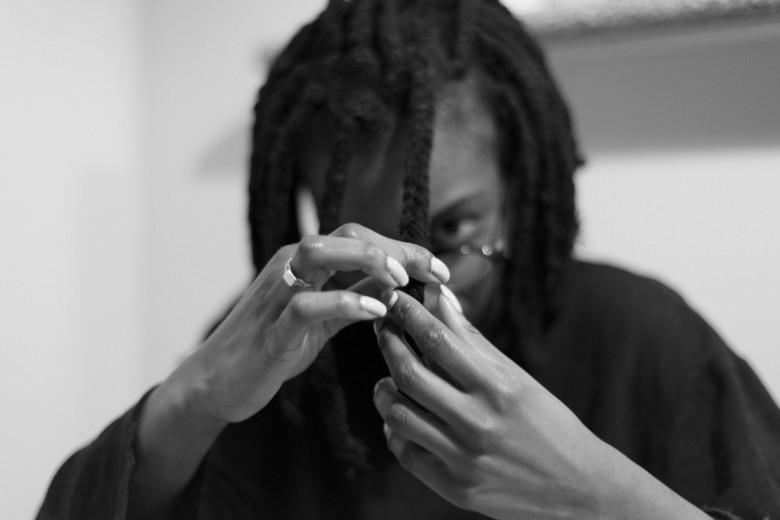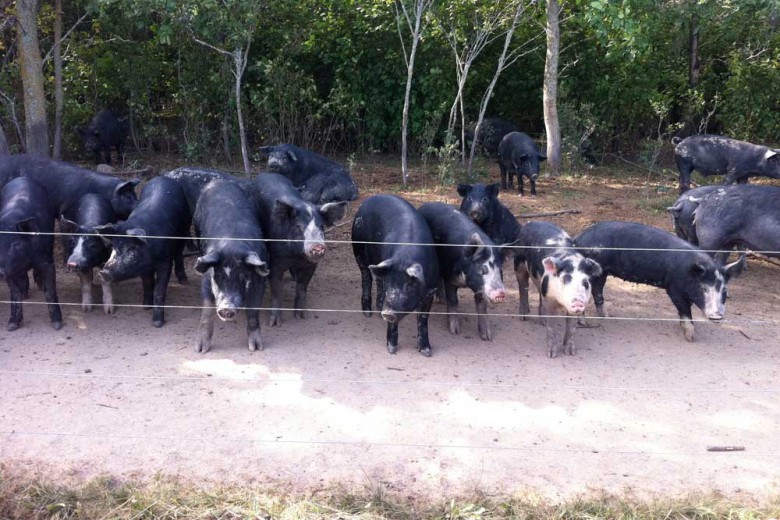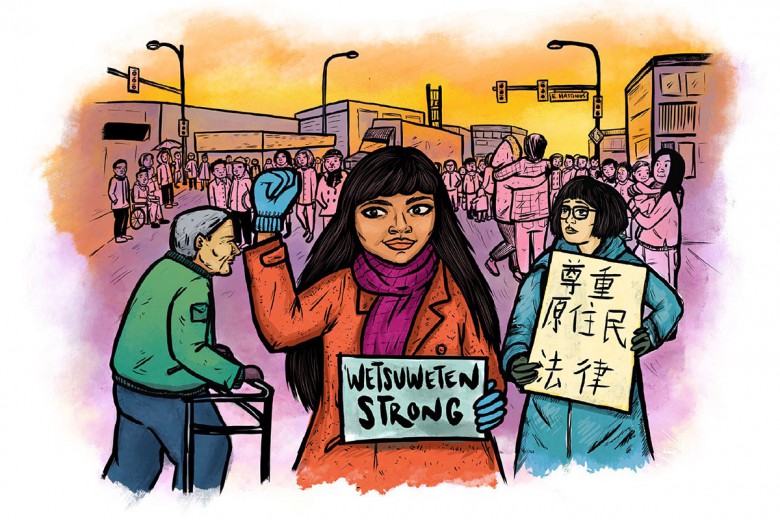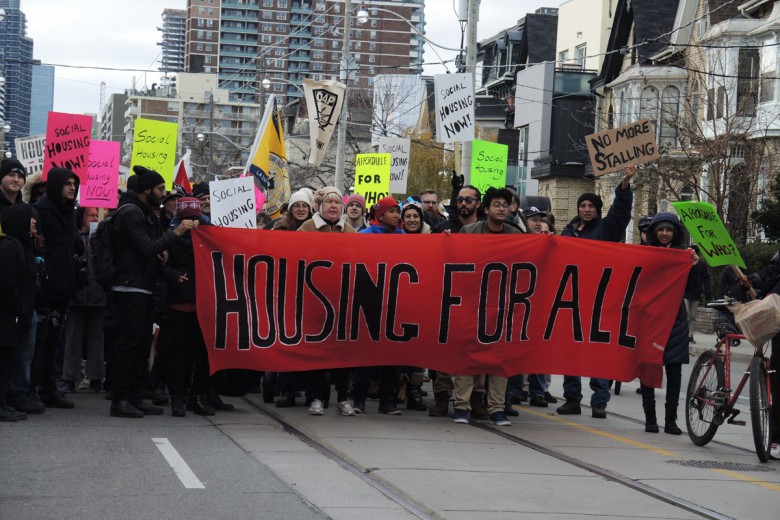*In June 2007, following generations of non-recognition, and 16 years of intensely personal battles with bureaucrats, governments, and the justice system, Sharon McIvor, a member of the Lower Nicola First Nation, successfully challenged sex discrimination in the Indian Act in British Columbia’s Supreme Court.
As one of thousands of Aboriginal women and their descendants who have been denied Indian status by the Indian Act, Sharon McIvor, a professor of Aboriginal law, feminist, and long-time activist devoted to defending the rights of Aboriginal women, has fought tirelessly to alter the oppressive legislation and ensure that her children and grandchildren be recognized as Status Indians.
Sharon McIvor’s fight to change the Indian Act began in 1985. The government had just amended the Act, ostensibly to remedy the gender inequity that had previously stripped Indian status from Aboriginal women who married men without status under the Indian Act, and from their descendants. Indian men, in contrast, had long conferred status upon whomever they married, and passed their status through their lineage.
Within months of the amendments, McIvor applied along with her children for registration as Status Indians of Lower Nicola Valley band. In February 1987, she learned that rather than eliminating the discrimination, the amendments simply postponed it for a couple of generations.
Under the revised Act, Sharon McIvor, the daughter of an Indian woman and a Non-status Indian man, could be recognized as a Status Indian, but, following the same sexist logic of before, her children could not. An important comparison to consider is the situation of McIvor’s hypothetical cousin, the child of her status uncle and non-status aunt: if her cousin married before 1985, he would have status, as would his wife (regardless of whether she held status before marriage) and children.
In May 1987, McIvor wrote a letter requesting a review of the decision. In February 1989, nearly two years later, a reply came upholding the denial of Indian status to her children. Later that year, McIvor took her case to the British Columbia Supreme Court.
McIvor launched a Charter challenge alleging that the status provisions in the Act were discriminatory as they preferred descendants who traced their Indian ancestry along paternal lines over those who traced ancestry along maternal lines. This time she would wait almost two decades for a decision.
Just before McIvor’s case went to court in August 2006, the government reversed its decision and amended the Crown’s statement of defence, conceding that McIvor’s children were in fact eligible for recognition as Status Indians.
The government noted that Sharon McIvor was an “illegitimate” child, and at the time she was born, illegitimate children were assumed to be Indian unless the paternity of the child was challenged and proven to be non-status. Since her father’s status had never been challenged by the Registrar, McIvor was in fact a Status Indian
As a Status Indian, McIvor was able to pass that status on to her children. But, because McIvor had married a Non-status man, her own children would not be able to pass on their Indian status to their children. The status the government was offering to McIvor meant that her children would essentially have half-status in that they could not pass it on to other generations.
The government presumably hoped this last-minute concession would placate McIvor and keep the sex discrimination challenge from proceeding in the courts. Although McIvor’s son was finally recognized as the Status Indian he was, she decided to press on with the challenge for the sake of her grandchildren (still denied Indian status) and all the other descendants of Aboriginal women who had similarly lost status.
In June 2007, B.C. Supreme Court Justice Carol Ross rendered her decision. Ross agreed with McIvor’s stance of so many years: the 1985 Indian Act status provisions, she found, contravene the Charter of Rights and Freedoms, discriminating on the basis of sex and marriage.
Historically, the Indian Act had long been a tool used by the Canadian government in its efforts to assimilate (“civilize”) Canada’s Indigenous peoples. The Act conflated all the diverse nations of Indigenous peoples into the administrative category of Indians, imposing colonial forms of governance on their communities and setting up strict rules to determine who could hold status as an Indian.
The various incarnations of this legislation functioned to overturn centuries-old systems of governance and inheritance, which were often matriarchal, and imposed supposedly civilized values that saw all the property in a marriage—indeed, even the wife and children themselves—as belonging to the man of the family.
While the initial 1850 Act for the Better Protection of the Lands and Property of Indians in Lower Canada defined Indian broadly, including those who married Indians or were adopted into Indian communities, this breadth soon narrowed.
In the 1857 Act to Encourage the Gradual Civilization of Indian Tribes, Indian men meeting specific criteria were offered enfranchisement, stripping not only them, but also their wives and children, of Indian status. This emphasis on the husband and father as determinant of status expanded in subsequent legislation.
In the language of the 1869 Act for the Gradual Enfranchisement of Indians and the Better Management of Indian Affairs, “any Indian woman marrying any other than an Indian, shall cease to be Indian”—as would the children of such a union.
By the 1876 Indian Act, male lineage became the sole determinant of status. Status Indian women who married men without Indian status lost status, while the wives of Status Indian men, even those without any Aboriginal ancestry whatsoever, became Status Indians.
Because Indian status regulated access to on-reserve residence and band support, these discriminatory provisions effectively banished thousands of women and their children from their communities and traditional homelands. This expulsion caused great psychological, emotional and economic suffering, particularly when marriages broke down and Aboriginal women were no longer allowed back to their home reserve.
This was the case with Sandra Lovelace. Raised on a Maliseet reserve, Lovelace had only been absent from her community for a few years during the period of her marriage, but Canadian legislation denied her both her identity and the right of return to her home. In December 1977, Sandra Lovelace filed a formal complaint against Canada to the United Nations Human Rights Committee. In 1981, the committee ruled that Canada was in violation of the International Covenant on Civil and Political Rights for effectively denying Aboriginal women access to their culture, religion and language.
The 1985 amendments were supposed to remedy all of this, but ultimately served only to postpone the discrimination for a later generation. Instead of eliminating discrimination, the 1985 amendments simply incorporated the preference for male lineage into the new regime.
Section 6(1)(a) of the Indian Act preserves full status for male Indians who married non-Indian women, and for persons who, prior to April 17, 1985, claim entitlement to registration through the male line of descent and through marriage to a male Indian. But the revised Act still withholds full section 6(1)(a) registration status from McIvor and other women who married non-Indian men, and from their children. Instead, Jacob Grismer, McIvor’s son, is relegated to 6(2) status: he holds status himself, but is unable to pass it on to his children unless he marries another Status Indian.
In the June 2007 ruling on McIvor’s case, Justice Ross declared the discriminatory status provision “of no force and effect” because it is inconsistent with the Charter. She found that the provision “authorizes the differential treatment of Indian men and Indian women born before April 17, 1985, and matrilineal and patrilineal descendants born before April 17, 1985.”
Justice Ross wrote, “The evidence of the plaintiffs is that the inability to be registered with full 6(1)(a) status because of the sex of one’s parents or grandparents is insulting and hurtful and implies that one’s female ancestors are deficient or less Indian than their male contemporaries. The implication is that one’s lineage is inferior. The implication for an Indian woman is that she is inferior, less worthy of recognition.”
Prior to the 1985 amendments, Sharon and her children had never applied for Indian status, knowing they did not qualify. When a woman lost her status, she was forced to leave her home and her reserve. She had to divest herself of any property she owned on the reserve, and was precluded from inheriting reserve lands. McIvor testified to the pain that she experienced due to her legal banishment from her community:
“My family and I suffered various forms of hurt and stigmatization because we did not have status cards. For example, members of my family wanted to observe our traditional lifestyle including the harvesting of berries, roots, and hunting and fishing . . . but because we lacked status cards we were required to do it covertly.”
She further elaborated on the painful exclusions that her family suffered from their community: “When I took my children to the annual Aboriginal Christmas party, there were no presents under the community tree for them because they were Non-status Indians. There are recognition ceremonies for young people when they graduate from high school. When my children graduated, there were no recognition ceremonies for them because they are Non-status Indians. Through incidents such as these I was made to feel the stigma that is attached to Indian women who have Non-status children.”
After years of alienation from her own community, McIvor was further dehumanized by having to continually fight to prove her identity and that of her family to bureaucrats and judges, taxing both her emotional and financial resources.
Unfortunately, McIvor’s costs do not stop here. The B.C. Supreme Court decision is being appealed by the Crown, and is ultimately expected to be resolved at the Supreme Court of Canada. This appeal will extend the process for at least another three years, and will cost, at minimum, a quarter of a million dollars.
Until recently, Sharon McIvor’s challenge was supported by the federal government’s Court Challenges Program, which provided funding to support court cases that advanced language and equality rights guaranteed under Canada’s Constitution. But in 2006, Stephen Harper cut the program’s funding, asserting that his government does “not intend to pay Liberal lawyers to challenge unconstitutional laws.”
McIvor’s response? “I spent 16 years bringing the challenge forward. I have experienced ongoing discrimination despite the federal government’s statements that Bill C-31 [the 1985 amendments] addressed the discrimination. In addition, the cost of bringing forward a Charter challenge is very expensive. The recent announcement cancelling the Court Challenges Program is a further blow to me and anyone who wants to bring a Charter challenge to address discrimination.”
This cancellation creates one more barrier for Sharon McIvor, who is fighting not only for her own family but also for an estimated 300,000 people across Canada who have lost status because of the gender discrimination in the Indian Act.
_Barbara Barker is currently articling with the Indian Claims Commission in Ottawa. Tyler McCreary teaches geography at the Northwest Community College in northern B.C.
For information on how to donate to the Sharon McIvor Case Fund, contact [email protected]. Cheques for the Sharon McIvor Case Fund (made out to “Heenan, Blaikie, in trust for Sharon McIvor”) can also be mailed to Heenan, Blaikie, Suite 2200, 1055 West Hastings Street, Vancouver, B.C. V6E 2E9._






